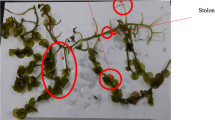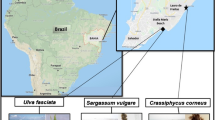Abstract
The nutritive value of Capsosiphon fulvescens (C. Agardh) Setchell et Gardner, a new developing species for cultivation of marine macroalgae in Korea, was assessed by comparison with common edible green seaweed Ulva prolifera (Oeder) J. Agardh collected from Korea and Japan, based on analysis of its chemical composition. The contents of protein and of total, essential, and free amino acids of C. fulvescens were significantly higher than those of U. prolifera, whereas those of lipid, carbohydrate, and total dietary fibres were significantly lower. There were no significant differences in the moisture content between Capsosiphon and Ulva species. The main minerals of Capsosiphon and Ulva are Na, Mg, K, Ca, and Al, making up approximately 97–99 % of the total minerals. The contents of Na and V of Capsosiphon were significantly greater than those of Ulva, while those of Mn and Sr were significantly lower in Capsosiphon. The contents of retinal (27.8 μg g−1 dry wt) and ascorbic acid (0.28 mg g−1 dry wt) of Capsosiphon were significantly higher than those of Ulva, but the contents of cobalamin were lower. These results suggest that C. fulvescens has greater potential to be used as human food and as an ingredient in formulated food.
Similar content being viewed by others
References
AOAC (2000) Official methods of analysis of international. Association of official analytical chemists international 17th edn. Gaithersburg, MD, USA
Bliding C (1963) A critical survey of European taxa in Ulvales. Part I. Capsosiphon, Percusaria, Blidingia, Enteromorpha. Opera Bot 8:1–160
Brown MR, Miller KA (1992) The ascorbic acid content of eleven species of microalgae used in mariculture. J Appl Phycol 4:205–215
Dubois M, Gilles KA, Hamiliton JK, Rebers PA, Smith F (1956) Colorimetric method for determination of sugars and related substance. Anal Chem 28:350–356
FAO/WHO (1973) Energy and protein requirements, Report of a Joint FAO/WHO Ad Hoc Expert Committee. WHO Technical Report Series No. 522; FAO Nutrition Meetings Report Series No. 52
Fleurence J, Chenard E, LuÇon M (1999) Determination of the nutritional value of proteins obtained from Ulva armoricana. J Appl Phycol 11:231–239
Fujiwara-Arasaki T, Mino T, Kuroda M (1984) The protein value in human nutrition of edible marine algae in Japan. Hydrobiologia 116/117:513–516
Hapette AM, Poulet SA (1990) Application of high-performance liquid chromatography to the determination of ascorbic acid in marine plankton. J Liquid Chromatogr 13:357–370
Hwang EK, Yi YH, Shin WJ, Sohn CH (2003) Growth and maturation of a green alga, Capsosiphon fulvescens, as a new candidate for seaweed cultivation in Korea. In: Champman RO, Anderson RJ, Vreeland VJ, Davison IR (eds) Seventeenth International Seaweed Symposium. Oxford University Press, Oxford, pp 59–64
Indegaard M, Minsaas J (1991) Animal and human nutrition. In: Guiry M, Blunden G (eds) Seaweed resources in Europe. Uses and potential. Wiley, New York, pp 21–64
Informatization Officer (1998) Statistical yearbook of maritime affairs and fisheries. Ministry of Maritime Affairs and Fisheries, Seoul
Ito K, Hori K (1989) Seaweed: chemical composition and potential food uses. Food Rev Int 5:101–144
Kakinuma M, Shibahara N, Ikeda H, Maegawa M, Amano H (2001) Thermal stress responses of a sterile mutant of Ulva pertusa (Chlorophyta). Fish Sci 67:287–294
Lahaye M (1991) Marine algae as sources of fibres: determination of soluble dietary fibre contents in some “Sea vegetables”. J Sci Food Agric 54:587–594
Mabeau S, Cavaloc E, Fleurence J, Lahaye M (1992) New seaweed based ingredients for the food industry. Int Food Ingred 3:38–45
Mathieson AC, Hehre EJ (1994) A comparison of the marine-algae from the Goleta Slough and adjacent open coast of Goleta, Santa-Barbara, California with those in the southern Gulf of Maine. Rhodora 96:207–258
Nisizawa K, Noda H, Kikuchi R, Watanabe T (1987) The main seaweed foods in Japan. Hydrobiologia 151/152:5–29
Noda H, Amano H, Arashima K, Hashimoto S, Nisizawa K (1989) Antitumour activity of polysaccharides and lipids from marine algae. Nippon Suisan Gakkaishi 55:1265–1271
Satake M, Mikajiri A, Makuta M, Fujita T, Murakami M, Yamaguchi K (1988) Occurrence and distribution of D-cysteinolic acid in fish and shellfish. Comp Biochem Physiol 90B:151–153
Sohn CH (1998) The seaweed resources of Korea. In: Critchley AT, Ohno M (eds) Seaweed resources of the world. Jap Int Coop Agency, Yokosuka, pp 15–33
SPSS (1999) SPSS© Base 9.0 Application Guide. SPSS, Chicago
Wright SW, Jeffrey SW (1997) High-resolution HPLC system for chlorophylls and carotenoids of marine phytoplankton. In: Jeffrey SW, Mantoura RFC, Wright SW (eds) Phytoplankton pigments in oceanography. UNESCO, Paris, pp 327–341
Acknowledgements
This work was partly supported by the Science Research Founds of Mokpo National University in 2007 and a grant (RP-2007-AQ-026) by NFRDI (National Fisheries Research & Development Institute), Korea.
Author information
Authors and Affiliations
Corresponding author
Rights and permissions
About this article
Cite this article
Hwang, E.K., Amano, H. & Park, C.S. Assessment of the nutritional value of Capsosiphon fulvescens (Chlorophyta): developing a new species of marine macroalgae for cultivation in Korea. J Appl Phycol 20, 147–151 (2008). https://doi.org/10.1007/s10811-007-9198-z
Received:
Revised:
Accepted:
Published:
Issue Date:
DOI: https://doi.org/10.1007/s10811-007-9198-z




